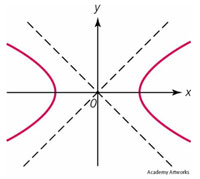
Conics are figures or shapes that are realized by slicing a cone at different angles. Click on the link below to go to the following website and see a good representation of the slicing of a cone, a short mathematical history of conics, and several examples of conics in the real world and their uses.
In this lesson, you will master the graphing of a hyperbola when given the equation of a hyperbola - in any form. You will understand the changes in the values of the coefficients and constants in the equation and how those changes are represented on the graph.

The standard form of any conic section is Ax2 + Bxy + Cy2 + Dx + Ey + F = 0, where A, B, C, D, E, and F are real numbers.
To form a hyperbola, it must be true that A and C have opposite signs (positive and negative). The absolute values of A and C may or may not be equal. This is what makes a hyperbola different from an ellipse and from a circle.
The “graph” form of the equation of a hyperbola is:
x minus h squared over a squared (x − h)2 (a)2 − y minus k squared over b squared (y − k)2 (b)2 = 1 OR y minus k squared over b squared (y − k)2 (a)2 − x minus h squared over a squared (x − h)2 (b)2 = 1